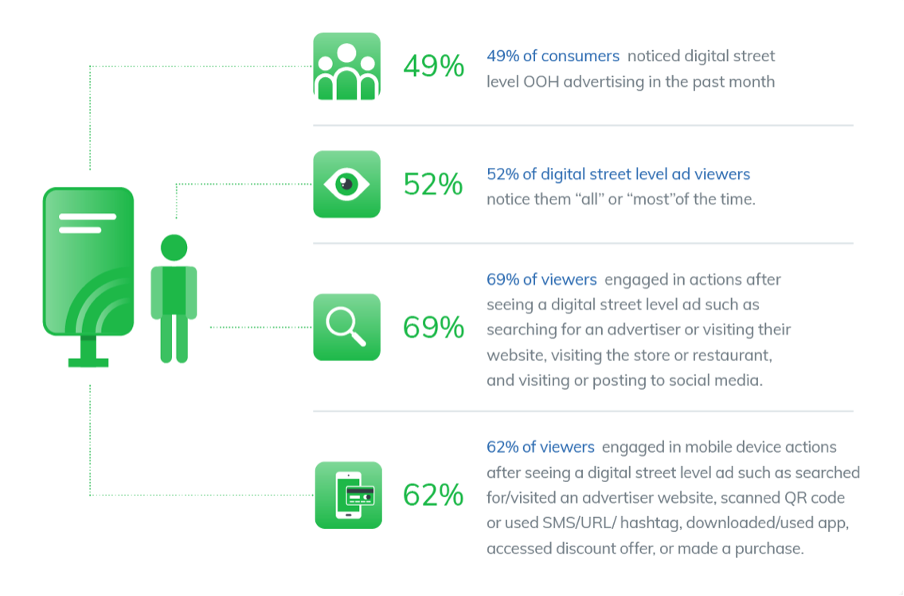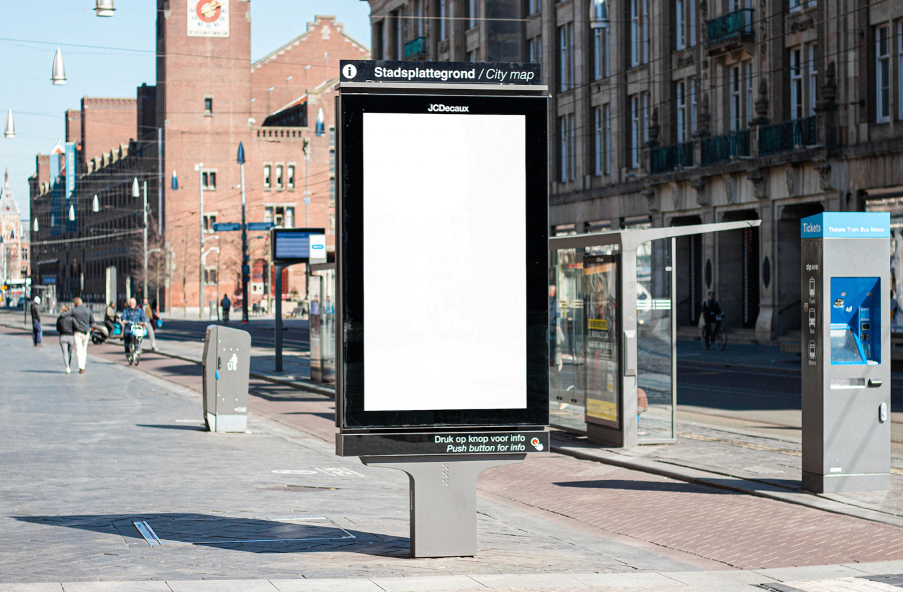Digital street furniture advertising is one of the most effective ways for SMBs not only to increase brand awareness but target their ideal customers at a face-to-face level.
Street furniture advertising includes all types of advertising at street level. Utilized by both large and small companies alike to great effect, digital street furniture ads are today found on everything from street level urban media panels to phone kiosks, bus shelters and other transit shelters, bus benches, newsstands and in transit stations.
Digital street furniture advertising is so effective because it targets a pedestrian audience, vehicular traffic, people waiting for public transportation and daily urban commuters. In short, if you want to raise brand awareness, a digital street furniture ad campaign is one of the most reliable methods of doing so.
How Brands Can Achieve More with a Digital Street Furniture Ad Campaign
Figures from the Out of Home Advertising Association of America (OAAA) reveal just how effective digital street furniture advertising is at engaging consumers and driving action.
The research found that nearly half of all consumers (49%) notice digital street furniture advertising – of whom 52% say they notice street furniture ads “all” or “most” of the time.
Perhaps more importantly, 69% of digital street furniture advertising viewers engage in actions after seeing street furniture ads. These actions include searching for the advertiser, visiting their website, store, or restaurant, or visiting or posting to social media.
The report also found that advertising on digital street furniture drives mobile action. 62% of viewers engaged in mobile device actions after seeing street furniture ads, such as scanning a QR code, using a hashtag, downloading an app, making a purchase, or posting to social media.

(Image source: oaaa.org)
What’s more, the report found that 51% of consumers noticed street furniture ads that gave them directions to a nearby business. Of these, 65% went on to visit that business where 92% made a purchase.

(Image source: oaaa.org)
In a separate report from the OAAA and The Harris Poll – Consumer Insights & Intent Q4 2022t: OOH Opportunities – OOH Social Media Engagement – it was found that social media users regularly see street furniture Out of Home advertising (OOH advertising) creative in photos across their feeds.
This is especially beneficial for advertisers, as it shows that street furniture OOH provides significant organic amplification opportunities for brands looking to increase brand awareness with their street furniture ads.
82% of TikTok users reported that they frequently notice OOH ads while on the platform, while 81% and 80% of Instagram and Facebook users respectively report the same. More than three-quarters of Snapchat and Twitter users also say they often see OOH ads in their feeds (78% and 76% respectively).

(Image source: oaaa.org)
Also worthy of note, is that across all platforms, it is millennials that are most likely to post images of outdoor ads on their social media profiles – though roughly half of all Gen Xers and Gen Z’ers do the same.

(Image source: oaaa.org)
The research also shows that nearly half of social media users (48%) engage with the Out of Home ads that they see in their social feeds by visiting the advertised company’s website. In addition, over a third are inspired to search for the company online, read reviews about their products and service, and/or ask friends and family about the brand.

(Image source: oaaa.org)
As Anna Bager, President and CEO of the OAAA puts it, “It is impressive to see how organically shared OOH ads on social platforms prompt brand engagement from users. This research underscores the deep connection between great out of home creative and social media – a connection that can supercharge a marketer’s OOH investment.”
Street Furniture Advertising – Top Tips for Success
Encourage Mobile and Social Media Action
As the OAAA research demonstrates, if you want your street furniture advertising to be seen by as many people as possible, you should build creatives that encourage mobile action and social media sharing.
“Creators are posting more Out of Home messages across their social media channels, meaning the stronger the creativity the greater likelihood for amplification,” said John Gerzema, CEO, The Harris Poll. “From TikTok to Instagram, OOH executions take on additional legs when the ideas create engagement and sharing. The best OOH also generates likes and clicks.”
A great example comes from Absolut Vodka, which created a social feed Digital Out of Home (DOOH) campaign at Singapore Changi Airport. The campaign encouraged users to upload a selfie along with travel tips – and the photos were featured on 57 digital displays across the airport.

(Image source: digitalsignagetoday.com)
Another great way to encourage mobile action with your digital street ads is to incorporate QR codes into your creatives which take users directly to a mobile landing page designed to drive specific customer actions – such as accessing a voucher or other offer.
QR codes are gaining huge popularity amongst marketers right now, with 90% agreeing that they will become increasingly important for successful DOOH campaigns over the next two years.
Read more – 3 Benefits of Incorporating QR Codes into Your DOOH Advertising
Use Programmatic DOOH Platforms to Target Your Audience
Today, advertising on digital street furniture displays is by no means a “hit and hope” type of venture. On the contrary, using powerful programmatic DOOH (pDOOH) platforms like The Neuron, advertisers can target pedestrians, traffic, commuters and people waiting for public transport at a granular level.
This is because pDOOH platforms utilize anonymized mobile location data (plus data from other sources) to work out precisely where various audiences spend their time and where they move throughout the days, weeks and months of the year.
Read more: 4 Easy Steps to Get Started with DOOH Advertising
What this means is that digital street furniture advertisers can literally pick their audiences as well as their screens – ensuring maximum exposure to the people that matter. In addition, advertisers can use pDOOH platforms to add contextual relevancy to their street advertising campaigns. How? By utilizing live external data – such as weather data, traffic data, news announcements, and sports results – to adjust campaigns in real-time.
For example, ANZ utilized bus timetables to create a dynamic campaign, encouraging people waiting for their bus to download the ANZ app and get on top of their finances.

(Image source: google.com)
Use the Free DOOH Design Studio to Craft High-Converting DOOH Ads in Minutes
If you’re looking to create the very best street furniture advertising creatives, you can do so in minutes using the free DOOH Design Studio from The Neuron.
Specially designed for digital signage and 100% free to use, the DOOH Design Studio comes with hundreds of ready-to-use vertical-specific DOOH templates, designed by outdoor advertising experts using proven techniques to maximize recall and effectiveness.

(Image source: theneuron.com)
With the DOOH Design Studio, you simply pick your template, add your logo (plus QR code or hashtag), customize the text, font and color scheme, and your ad is ready.
Read more: 5 Top Design Tips for a Successful DOOH Campaign
You can then use The Neuron pDOOH platform to hand select the perfect Out of Home advertising screens on which to display your ad, set your criteria (time of day, day of week, target demographic, etc.), and launch your campaign. Once your ad is live, you can track its performance easily and optimize for the best results.


